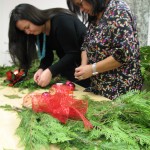Implementation plan to help unlock lands for tribal economic development, self-governance purposes; initial plan emphasizes tribal consultation, flexibility as keys to success
Press Release, U.S. Department of the Interior, www.doi.gov
WASHINGTON D.C. –The Department of the Interior today announced the initial framework of the Land Buy-Back Program for Tribal Nations that will purchase fractional interests in American Indian trust lands from willing sellers, enabling tribal governments to use the consolidated parcels for the benefit of their communities.
The initial implementation plan, based on consultation with tribes, outlines how Interior will carry out the land consolidation component of the Cobell Settlement, which provided a $1.9 billion fund to purchase the fractionated interests in trust or restricted land, at fair market value, within a 10 year period. These acquired interests will remain in trust or restricted status through transfer to tribes.
“Freeing up fractionated lands for the benefit of tribal nations will increase the number of acres in tribal land bases, stimulate economic development and promote tribal sovereignty and self-determination,” said Deputy Secretary of the Interior David J. Hayes. “This initial plan will guide this landmark effort, and we will continually update the plan to reflect lessons learned and tribal input. We know that success will only happen with the leadership of tribes, and we look forward to working through our nation-to nation relationship to implement the important initiative.”
As outlined in a Secretarial Order also announced today, the organizational structure for the Buy-Back Program will consist of a core group in the Office of the Secretary to provide management and performance expertise under the supervision of a Program Manager. The program relies on the extensive expertise and services within Interior, primarily in the Bureau of Indian Affairs and the Office of Special Trustee for American Indians, to implement the operational aspects, including valuations and acquisitions.
To ensure high-level accountability, Secretary of the Interior Ken Salazar has established an oversight board, which includes the Deputy Secretary, Solicitor, Director of the Bureau Indian Affairs and the Special Trustee for American Indians.
Fractionation of Indian lands stems primarily from the General Allotment Act of 1887 which allotted tribal lands to individual tribal members, often in 80 or 160-acre parcels. The lands have been handed down to heirs over successive generations, causing the number of shared interests in one parcel to grow exponentially. Currently, more than 92,000 tracts of land held in trust for American Indians contain 2.9 million fractional interests.
When tracts have so many co-owners, it is often difficult and impractical to obtain the required approvals to lease or otherwise use the lands. As a result, highly-fractionated tracts lie idle, unable to be used for any economical or beneficial purpose or for direct use by tribal communities for their members.
“This program is our chance to begin to solve a fractionation problem that has plagued Indian Country for decades,” said Kevin K. Washburn, Assistant Secretary for Indian Affairs. “Tribal leadership and community participation are the cornerstones of this program, and we look forward to extensive communication and continuing consultation with Indian Country as we move forward.”
The plan will use a flexible, adaptive management approach to make continuing improvements based on tribal feedback, lessons learned, and best practices. To unlock the beneficial use of the land and facilitate economic development, the proposed acquisition strategy will prioritize the consolidation of the most highly fractioned tracts of land and will structure acquisitions to maximize the number of tracts in which the tribe gains a controlling ownership interest. To achieve this goal, the Program will target fractionated tracts that are most amenable to cost-efficient valuation techniques.
The Buy-Back Program will be structured to allow as much opportunity for tribal participation and assistance as practical, including consulting with Indian tribes to identify acquisition priorities. The program will actively report progress and communicate with tribal communities throughout the life of the initiative.
Interior has been working on land consolidation efforts since the program was authorized by the Claims Resolution Act of 2010, but could not officially implement the program until the settlement was considered final on Nov. 24, 2012 after appeals were exhausted through the U.S. Supreme Court.
“Now that the Cobell Settlement is final, we are eager to connect with American Indian individuals and tribal leaders across Indian Country about the opportunities the program has to offer,” said Interior Solicitor Hilary Tompkins. “We urge tribal leaders to participate in the consultation processes outlined in the initial implementation plan, including the upcoming consultation sessions.”
As part of the Interior’s continuing dialogue with tribal nations, Interior will host three consultation sessions early next year to discuss the Initial Implementation Plan and receive tribal feedback — on Jan. 31 in Minneapolis, MN; on Feb. 6 in Rapid City, SD; and on Feb. 14 in Seattle, WA.
The Initial Implementation Plan reflects the comments received from tribal consultation sessions in the summer and fall of 2011 and the draft Implementation Plan released in January, 2012. The plan outlines the initial goals and priorities of the program, summarizes key parameters and operational concepts, and outlines ways in which tribes can participate in the Buy-Back Program through cooperative agreements. The Initial Implementation Plan is available for public comment for 75 days.
Interior holds about 56 million acres in trust for American Indians. More than 10 million acres are held for individual American Indians and nearly 46 million acres are held for Indian tribes. The department holds this land in more than 200,000 tracts, of which approximately 92,000 contain fractional ownership interests subject to purchase by the Buy-Back Program.
For additional information on the Buy-Back Program for Tribal Nations and to view the Initial Implementation Plan, please visit www.doi.gov/buybackprogram.
For information about the individual class-action payments under the Cobell Settlement, please contact GCG, Inc. at 1-800-961-6109 or via email at Info@IndianTrust.com.
























